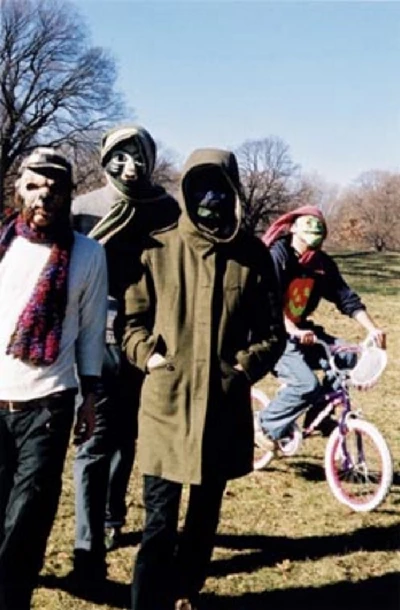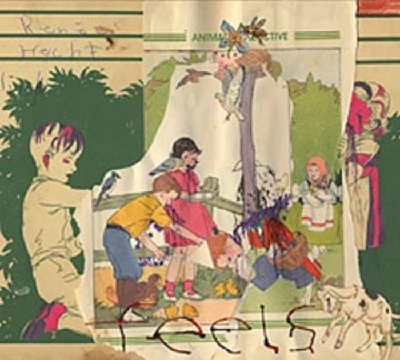published: 17 /
9 /
2005

With their new album 'Feels' just out, Dominic Simpson profiles the career of idiosyncratic and experimental New York-based American psychedelia act the Animal Collective
Article
From Brooklyn, and part of an exciting scene of bands that coalesce in that area and share practice space, gigs, etc., such as Black Dice, Gang Gang Dance, and White Magic, the Animal Collective have been producing the most extraordinary, off-kilter psychedelia for a while now.
While each explore different sounds, these bands share an aesthetic towards the idiosyncratic – particularly in their unconventional, often bizarre shamanistic live sets - that has united them. So just as Gang Gang Dance envisage some strange hybrid of Can’s voodoo repetition, dub’s use of echo and space, electronic music’s spiralling poly-rhythms, and ethnological trance vocals (inspired by field recordings), the Animal Collective have explored anthropomorphism, regression into child-like states of wonder, and psychedelia in their music. The preoccupation with animals and nature has long been present in music, of course, from much folk, through to the (often heavily bearded) prog rockers and their Tolkien / Dungeons & Dragons obsessions (orcs, elves, druids, etc) through to Syd Barrett, hippy spacerockers the Ozric Tentacles, and even the ‘trance’ techno of the 90’s, which used much ‘back-to-nature’ imagery and had a quasi-pagan edge - one that was often linked with the new-age traveller and squat scene at that time (such as with collectives like Spiral Tribe).
Initially a duo of core members Avey Tare and Panda Bear (they’ve since added two other members, Geologist and Deaken), the Animal Collective have tapped into the use of animistic imagery in their music not just with song titles like ‘Who Could Win A Rabbit’, but also with their stage shows, which often feature the band unrecognisably dressed in various animal costumes and with numerous unconventional props. Their psychedelic folk come not from the usual lazy preconceptions (Hendrix-style guitar solos, the use of sitar, a guitar in modal tuning), but rather from the way their acoustics will be refracted through delay to create endless waves of tumbling haze, as if the sun’s cosmic rays hit you in sound rather than in heat. This was demonstrated best on both ‘Visiting Friends’, the droning twelve-minute track at the middle of their outstanding 'Sung Tongs' album, and on ‘Baleen Sample’, one of the tracks on their 'Prospect Hummer' EP in which they collaborated with British folk chanteuse Vashti Bunyan.
To this palette, they’ve added percussive drums (which hardly ever form a conventional, ‘normal’ drum beat), chirping keyboards, high-pitched vocal harmonies, and the disorientating use of high-frequency, frequently sped-up ranges, a sound that was first explored on their debut 'Spirit They’ve Gone, Spirit They’ve Vanished'. It had a playfulness that brought to mind the inquisitive spirit of children, but the next two releases, 'Danse Manatee' and 'Here Comes The Indian' (they also released another, "unofficial" album called 'Campfire Songs', which was exactly the back-to-basics simplicity that the title suggests, the band literally out on the back porch in the open air), were heavier affairs, as if the band were keen to shrug off any ‘twee’ label.
'Here Comes The Indian' in particular is their darkest, heaviest record to date. With its chaotic explosions of anarchic sound, intense effects, pagan chanting, and distorted vocals, its claustrophobic sound – recorded in the middle of New York’s scorching summer - is more like a freakout on bad acid than any pastoral strumming, resembling what the Flaming Lips would be like if they were in an extremely bad mood. Last year’s 'Sung Tongs' album, meanwhile, along with the aforementioned 'Prospect Hummer' EP collaboration, were their most assessable releases yet, a distillation of the first two albums’ pop aesthetic with partial nods towards the more abrasive elements of 'Here Comes The Indian' . The songwriting, crucially, was the best they have ever produced.
And now we have 'Feels', their latest for Fat Cat.
The album begins with the sound of children laughing and playing on ‘Did You See The Words’, a reminder of the Animal Collective's obsession with child-like fantasy worlds, before a twinkling piano vies with a galloping rhythm and some sparkling Beach Boys-style rhythm.‘Grass’ is an up-tempo number that sees the pop tendency within the Animal Collective fighting with the freeform noise element to create something in-between, with a catchy “woo woo” chorus of sorts; at times, it bizarrely brings to mind David Bowie, of all people.
‘Flesh Canoe’ meanwhile, echoes My Bloody Valentine in it’s translucent, shifting layers of dense treated guitar noise, to the point where it sounds less like conventional chords or notes and more like oscillating waves of shimmering sound, constantly ebbing and flowing like a river. It’s as if the song is seen opaquely through stained glass, hazily shifting by; in some way’s it almost a strange cousin of ‘All I Need’ off My Bloody Valentine’s 'Isn’t Anything'. The lyrics, mostly echoed and buried deep within the mix, remain a mystery. ‘The Purple Bottle’ begins with some African drum rhythms before an echoing guitar pattern sets in, the lyrics providing an obscure tale about finding the purple bottle of the title in a park, used as a metaphor for the heart of an unnamed person. Over the song’s six minutes, the drums become climatic against the simple flow of the guitar.
Perhaps as a reaction to the first four tracks, the second part of the album slows things down. ‘Bees’ is a swirling, tumbling web of lulling dulcimers, over which the band perfect their sleepy harmonies. Even more impressive is ‘Banshee Beat’, which is nothing like the title suggests: over slowly undulating guitar motif and vocals, the song is an ocean of serenity, with the momentum building slowly through it’s eight minutes’ duration, a simple drum pattern becoming more pronounced as the song progresses. A beautifully calm and almost spiritual piece, its the standout track on the album, with ‘Daffy Duck’ and ‘Loch Raven’ continuing the similarly relaxed feel, buoyed along by tinkering electronic piano and violin melodies provided by Múm’s Kristín Anna Valtysdóttir and Oregon-born Eyvind Kang, the latter having worked with the likes of DNA’s Arto Lindsay, Mr Bungle, Laurie Anderson and Sun City Girls.
Whilst these tracks operate as a contrast with the first half’s frenetic vibe, the final track, ‘Turn Into Something’, is as exuberantly upbeat and accessible as anything they’ve done. It’s here that the crucial difference between this album and 'Sung Tongs' is made apparent: while that album was mainly acoustic based and built around the duo of Avey Tare and Panda, 'Feels' is far more a collaborative effort between the four members of the band, and one that relies less on any folk-inflected melody.
Not that it’s compromised their sound: they still remain one of the most unique and brilliantly inventive bands around. If it’s not as instantly accessible as 'Sung…', that’s not to deny Feels’ richness and dazzling experimentation.
Picture Gallery:-
